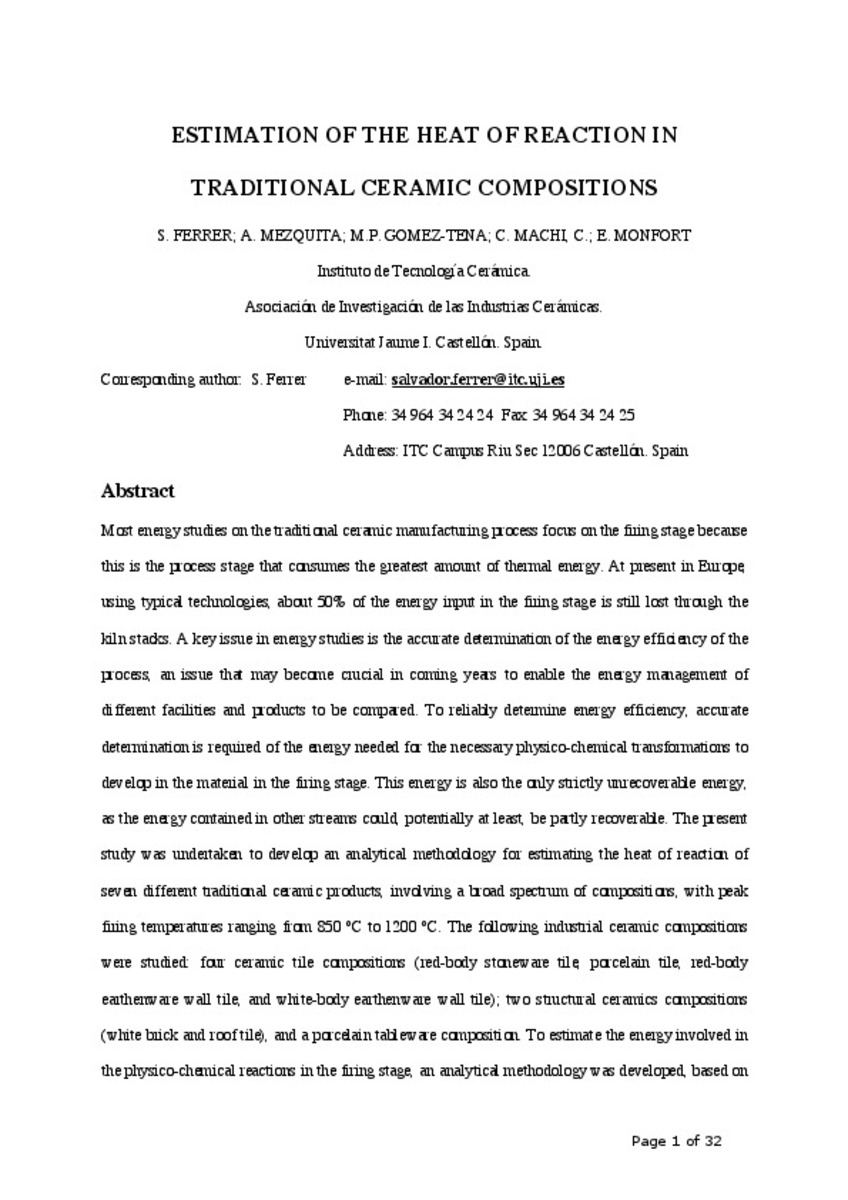Mostrar el registro sencillo del ítem
Estimation of the heat of reaction in traditional ceramic compositions
| dc.contributor.author | Ferrer, S. | |
| dc.contributor.author | Mezquita, Ana | |
| dc.contributor.author | Gómez-Tena, Maria Pilar | |
| dc.contributor.author | Machí, Cristina | |
| dc.contributor.author | Monfort, Eliseo | |
| dc.date.accessioned | 2016-04-25T07:54:57Z | |
| dc.date.available | 2016-04-25T07:54:57Z | |
| dc.date.issued | 2015-05 | |
| dc.identifier.citation | FERRER, S.; MEZQUITA, Ana; GÓMEZ TENA, María Pilar; MACHÍ, Cristina; MONFORT GIMENO, Eliseo. Estimation of the heat of reaction in traditional ceramic compositions. Applied Clay Science (2015), v. 108, p. 28-39 | ca_CA |
| dc.identifier.uri | http://hdl.handle.net/10234/158925 | |
| dc.description.abstract | Most energy studies on the traditional ceramic manufacturing process focus on the firing stage because this is the process stage that consumes the greatest amount of thermal energy. At present in Europe, using typical technologies, about 50% of the energy input in the firing stage is still lost through the kiln stacks. A key issue in energy studies is the accurate determination of the energy efficiency of the process, an issue that may become crucial in coming years to enable the energy management of different facilities and products to be compared. To reliably determine energy efficiency, accurate determination is required of the energy needed for the necessary physico-chemical transformations to develop in the material in the firing stage. This energy is also the only strictly unrecoverable energy, as the energy contained in other streams could, potentially at least, be partly recoverable. The present study was undertaken to develop an analytical methodology for estimating the heat of reaction of seven different traditional ceramic products, involving a broad spectrum of compositions, with peak firing temperatures ranging from 850 oC to 1200 oC. The following industrial ceramic compositions were studied: four ceramic tile compositions (red-body stoneware tile, porcelain tile, red-body earthenware wall tile, and white-body earthenware wall tile); two structural ceramics compositions (white brick and roof tile), and a porcelain tableware composition. To estimate the energy involved in the physico-chemical reactions in the firing stage, an analytical methodology was developed, based on the mineralogy data of the unfired body composition and on the enthalpy of formation of the minerals in the fired tiles. The methodology was validated by comparing the results with experimental data. | ca_CA |
| dc.description.sponsorShip | This study was funded by the Valencian Institute of Business Competitiveness (IVACE)in the Competitiveness Improvement Programme through project IMAMCA/2014. | ca_CA |
| dc.format.extent | 32 p. | ca_CA |
| dc.format.mimetype | application/pdf | ca_CA |
| dc.language.iso | eng | ca_CA |
| dc.publisher | Elsevier | ca_CA |
| dc.relation.isPartOf | Applied Clay Science (2015), v. 108 | ca_CA |
| dc.rights.uri | http://rightsstatements.org/vocab/CNE/1.0/ | * |
| dc.subject | Heat of reaction | ca_CA |
| dc.subject | Physico-chemical transformations | ca_CA |
| dc.subject | Energy efficiency | ca_CA |
| dc.subject | Firing | ca_CA |
| dc.subject | Traditional ceramics | ca_CA |
| dc.title | Estimation of the heat of reaction in traditional ceramic compositions | ca_CA |
| dc.type | info:eu-repo/semantics/article | ca_CA |
| dc.identifier.doi | http://dx.doi.org/10.1016/j.clay.2015.02.019 | |
| dc.rights.accessRights | info:eu-repo/semantics/openAccess | ca_CA |
| dc.relation.publisherVersion | http://www.sciencedirect.com/science/article/pii/S0169131715000708 | ca_CA |
| dc.edition | Preprint | ca_CA |
| dc.type.version | info:eu-repo/semantics/submittedVersion |
Ficheros en el ítem
Este ítem aparece en la(s) siguiente(s) colección(ones)
-
QUI_Articles [300]







